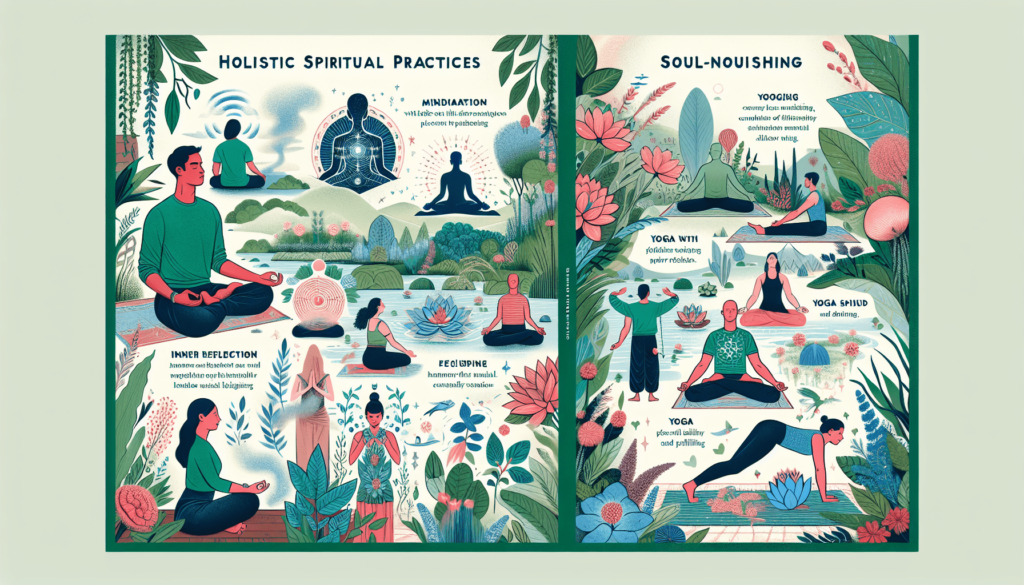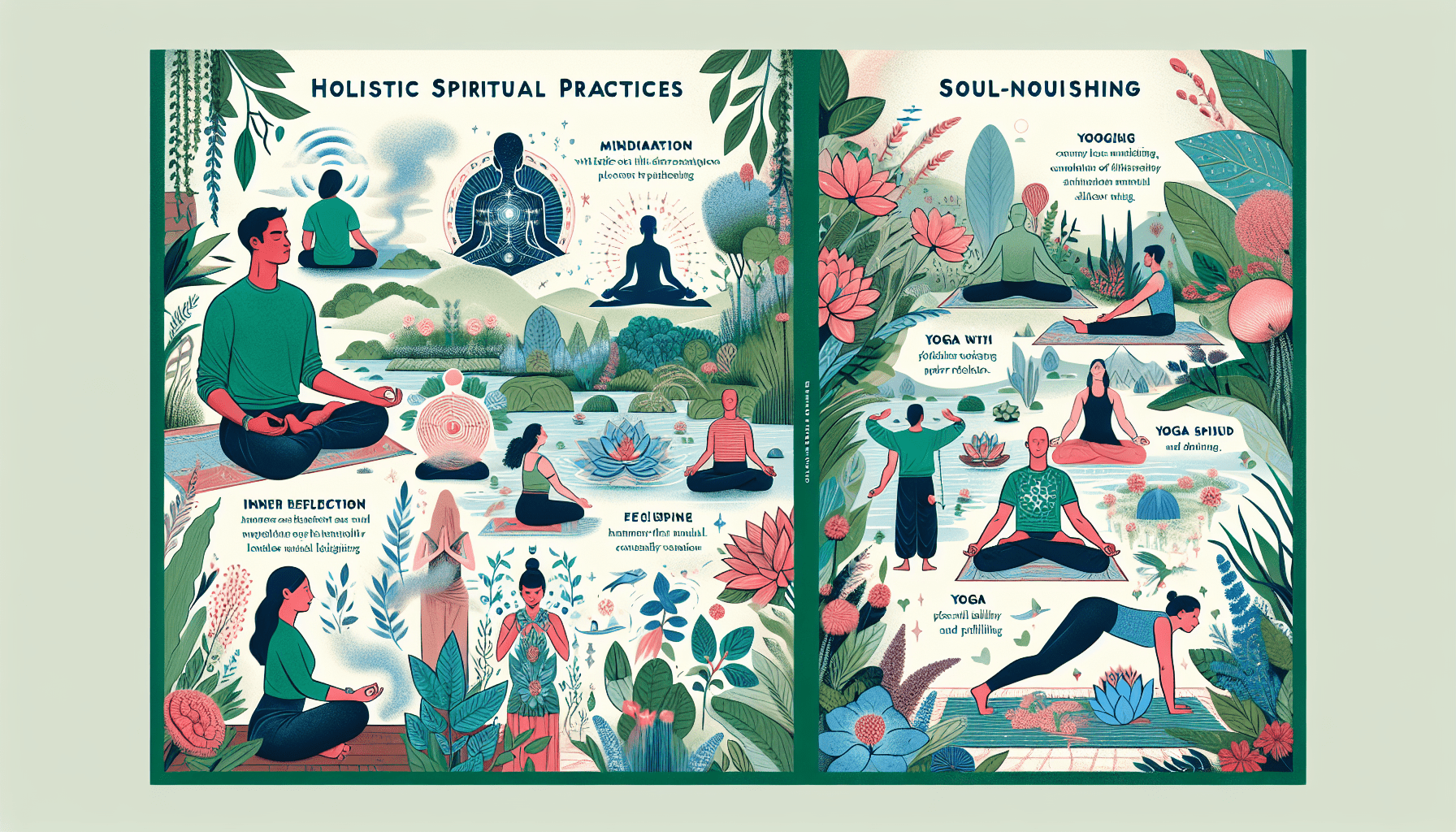In this article, you will discover a wealth of spiritual practices that will help you cultivate a holistic and balanced life. With a focus on nurturing the soul, we will explore methods that facilitate personal growth, inner peace, and connection with the divine. These practices encompass a variety of traditions and can be incorporated into your daily routine to enhance your overall well-being. Whether you are seeking to deepen your spiritual journey or simply looking for ways to enhance your daily life, the insights shared here will provide you with valuable tools to nourish your soul and embrace a more harmonious way of living. So, let’s embark on this transformative journey together and lay the foundation for a more fulfilling and meaningful existence.

Meditation and Mindfulness
Benefits of meditation and mindfulness
Meditation and mindfulness practices have numerous benefits for your overall well-being and spiritual growth. By dedicating time to quiet contemplation and inner reflection, you can experience a sense of calm and clarity, reduce stress and anxiety, improve focus and concentration, and enhance self-awareness. Regular meditation can also lead to a deeper connection with your inner self and a greater sense of purpose and meaning in your life. Moreover, mindfulness practices can help you cultivate a sense of gratitude and compassion, as well as promote a more positive and present mindset.
Different types of meditation practices
There are various types of meditation practices you can explore to find what resonates with you the most.
-
Mindfulness Meditation: This practice involves paying attention to the present moment without judgment, observing your thoughts and emotions as they arise and letting them go.
-
Loving-Kindness Meditation: Also known as Metta meditation, this practice involves cultivating feelings of love, kindness, and compassion towards yourself and others.
-
Transcendental Meditation: This technique involves the use of a mantra to achieve deep relaxation and the awakening of higher consciousness.
-
Guided Visualization: In this form of meditation, you imagine yourself in a peaceful and serene setting, using your imagination to evoke positive emotions and sensations.
-
Walking Meditation: This meditation practice involves walking slowly and mindfully, paying attention to each step and the sensations in your body.
How to start a meditation practice
Starting a meditation practice doesn’t have to be intimidating. Follow these steps to get started:
-
Create a dedicated space: Find a quiet and comfortable space where you can meditate without distractions. You can decorate it with soothing elements like candles, crystals, or plants to enhance the atmosphere.
-
Set a regular practice time: Choose a time of day when you can commit to meditating consistently. Establishing a routine will help you make it a daily habit.
-
Begin with short sessions: Start with just a few minutes of meditation each day and gradually increase the duration as you become more comfortable.
-
Focus on your breath: Pay attention to the sensation of your breath, inhaling deeply and exhaling slowly. Whenever your mind starts to wander, gently bring your attention back to your breath.
-
Experiment with different techniques: Explore different meditation techniques to find what resonates with you. You can try guided meditations, mantra meditation, or explore various apps or online resources to enhance your practice.
Tips for practicing mindfulness in daily life
In addition to formal meditation sessions, you can incorporate mindfulness into your everyday life. Here are some tips:
-
Be present: Practice being fully present in each moment, savoring the sights, sounds, and sensations around you.
-
Engage your senses: Pay attention to the taste, texture, and aroma of your food, the feeling of the air on your skin, or the sounds of nature. Engaging your senses can help anchor you in the present moment.
-
Practice non-judgment: Notice your thoughts and emotions without labeling them as good or bad. Simply observe them with curiosity and acceptance.
-
Take mindful breaks: Throughout the day, take short breaks to bring your attention back to the present moment. Close your eyes, take a few deep breaths, and notice how you feel in your body and mind.
-
Be kind to yourself: Cultivate self-compassion by embracing imperfections and treating yourself with kindness and understanding. Acknowledge your achievements and practice gratitude for the little things in life.
By incorporating meditation and mindfulness into your daily routine, you can experience a deeper sense of peace, self-awareness, and connection to the present moment.
Yoga and Movement
Physical and mental benefits of yoga
Yoga provides not only physical benefits but also mental and emotional well-being. Regular yoga practice can improve flexibility, strength, and posture. It can also enhance your cardiovascular health, balance, and coordination. Beyond the physical benefits, yoga helps to calm and focus the mind, reducing stress and anxiety. It promotes relaxation, improves sleep quality, and boosts overall mental clarity and emotional stability. Yoga is a holistic practice that nurtures the body, mind, and spirit.
Different types of yoga practices
There are various styles and types of yoga to suit different needs and preferences. Here are a few popular ones:
-
Hatha Yoga: This traditional style of yoga focuses on physical postures (asanas) and breath control (pranayama) to promote balance, flexibility, and relaxation.
-
Vinyasa Yoga: Also known as flow yoga, vinyasa involves continuous movement through a sequence of poses synchronized with breath. It builds strength, improves endurance, and promotes mindfulness.
-
Iyengar Yoga: This style emphasizes precise alignment and the use of props such as blocks and straps. It is suitable for those looking for a more detailed and therapeutic approach to yoga.
-
Bikram Yoga: Bikram Yoga consists of a series of 26 poses practiced in a heated room. It aims to detoxify the body, improve flexibility, and enhance mental focus.
-
Kundalini Yoga: Kundalini Yoga combines physical postures, breathing techniques, chanting, and meditation to awaken and balance the energy within the body. It is known for its spiritual and transformative effects.
Finding the right yoga style for you
When choosing a yoga style, consider your goals, preferences, and physical condition. If you are looking for a more gentle and restorative practice, Hatha or Yin Yoga might be suitable. For those seeking a more vigorous and dynamic workout, Vinyasa or Ashtanga Yoga may be a better fit. Experiment with different styles and teachers to find what resonates with you.
Incorporating movement into your daily routine
Aside from yoga, incorporating movement into your daily routine can have profound benefits for your physical and mental well-being. Here are some ideas to get you started:
-
Take regular walks: Walking is a simple yet effective way to stay active. Aim to incorporate daily walks into your routine, whether it’s a leisurely stroll in nature or a brisk walk around your neighborhood.
-
Try mindful movement practices: Explore other mindful movement practices such as Tai Chi, Qigong, or dance. These practices can enhance body awareness, gracefulness, and overall vitality.
-
Dance it out: Put on your favorite music and dance like nobody’s watching. Dancing is not only a joyful form of self-expression but also a great way to get your heart rate up and release stress.
-
Cultivate a home yoga practice: Set aside a dedicated space at home for yoga and commit to practicing regularly. Create your own sequences or follow online yoga classes or videos.
By incorporating yoga and movement into your daily routine, you can nurture your body, calm your mind, and cultivate a deeper connection to your physical self.

Prayer and Gratitude
The power of prayer in spiritual growth
Prayer is a deeply personal and powerful practice that connects us to a higher power, the divine, or our inner wisdom. It is a way to express our deepest desires, seek guidance, and find solace. Prayer can bring a sense of peace, comfort, and hope, and it can also serve as a tool for self-reflection and personal growth. Through prayer, we open ourselves to the mysteries of the universe and strengthen our connection to something greater than ourselves.
Different prayer techniques and traditions
Prayer takes various forms across different religious and spiritual traditions. Some common prayer techniques include:
-
Invocation or Affirmation: Invoking the divine or reciting affirmations or mantras that align with your intentions and desires.
-
Intercessory Prayer: Praying on behalf of others, expressing compassion and asking for healing, guidance, or protection for loved ones.
-
Contemplative Prayer: Engaging in silent or meditative prayer, creating space for inner stillness and receptive listening.
-
Gratitude Prayer: Expressing thanks for the blessings and abundance in your life, cultivating an attitude of gratitude and appreciation.
-
Prayer through Rituals: Engaging in rituals or ceremonies that hold symbolic meaning and help you connect with the divine.
Cultivating gratitude in your life
Gratitude is a powerful practice that can transform your perspective and bring more joy and contentment into your life. By cultivating gratitude, you shift your focus from what is lacking to what is already present. Here are some ways to cultivate gratitude:
-
Keep a gratitude journal: Take a few moments each day to write down things you are grateful for. It can be as simple as a beautiful sunset or a kind gesture from a friend. Regularly reflecting on these moments of gratitude can shift your mindset towards positivity.
-
Express gratitude to others: Share your appreciation with the people in your life. Write thank you notes, express your gratitude in person, or simply acknowledge the positive qualities you see in others.
-
Practice mindfulness of the present moment: Be fully present in each moment and notice the little joys and blessings that surround you. This can be as simple as savoring a delicious meal or enjoying a peaceful walk in nature.
-
Count your blessings: Take a few deep breaths and mentally count your blessings, focusing on both the big and small things you are grateful for. This practice can help you shift your perspective and foster a deeper sense of appreciation.
By incorporating prayer and gratitude into your daily life, you can nurture a deeper sense of connection, find solace in moments of challenge, and cultivate a heart filled with gratitude and compassion.

